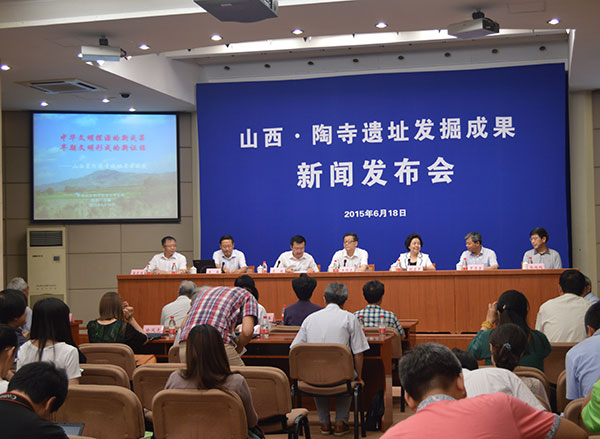Major archeological findings at Taosi ruins in Shanxi
Updated: 2015-06-19 13:25
(chinadaily.com.cn)
|
||||||||
 |
|
A press conference on the archeological findings and research results on the Taosi site in Linfen is held at Beijing, June 18, 2015. [Photo by Liu Xuanyi/chinadaily.com.cn] |
Yao was one of the sage emperors living in the middle reaches of the Yellow River in Chinese mythology. Excavation of the Taosi site in Linfen city, North China's Shanxi province, began in l978.
Wang Wei, head of the institute of archeology under the Chinese Academy of Social Sciences, said that many experts in the archaeological circle have reached a consensus that Taosi is the capital of the Yao period.
Latest excavations also showed the ancient city of Taosi covered an area of 2.8 million square meters with various functional divisions, including a royal palace, residential areas for nobles, the king’s mausoleum, and a ritual platform.
Meanwhile, the concept of kingship,etiquette, private ownership, and an ancient calendar were also developed in the period of Yao, according to Wang's report.
Wang said that a series of archeological findings at the Taosi site proves that it matches the capital of the Yao period 4,200 years ago in terms of the period, location, scale, and level of civilization.
Although the findings may still face some disputes, Chinese archeologists believe that through archaeological excavation and research, the legendary Emperor of Yao will become a true part of the history of China.

 Painter uses butterfly wings as canvases
Painter uses butterfly wings as canvases
 Ten photos you don't wanna miss – June 18
Ten photos you don't wanna miss – June 18
 Man with 15 girlfriends charged with fraud
Man with 15 girlfriends charged with fraud
 Heavy rain, flood hit many parts of China
Heavy rain, flood hit many parts of China
 Muslims around the world mark first eve of holy month
Muslims around the world mark first eve of holy month
 Top 5 wealthiest women in technology
Top 5 wealthiest women in technology Warriors beat Cavaliers to clinch NBA title
Warriors beat Cavaliers to clinch NBA title
 Saving dogs from dog meat carnival
Saving dogs from dog meat carnival
Most Viewed
Editor's Picks

|

|

|

|

|

|
Today's Top News
Talks seen as prelude to visit by President Xi to US in September
Gunman kills nine people in South Carolina church shooting
US House moves to revive Obama's Pacific trade pact
Hong Kong lawmakers reject election reform proposal
Lies and false hopes entrap Xinjiangers
China's economic strategy focus of panel
UN strategy for long term
topic of debate
Donald Trump announces bid for
US presidency
US Weekly

|

|








